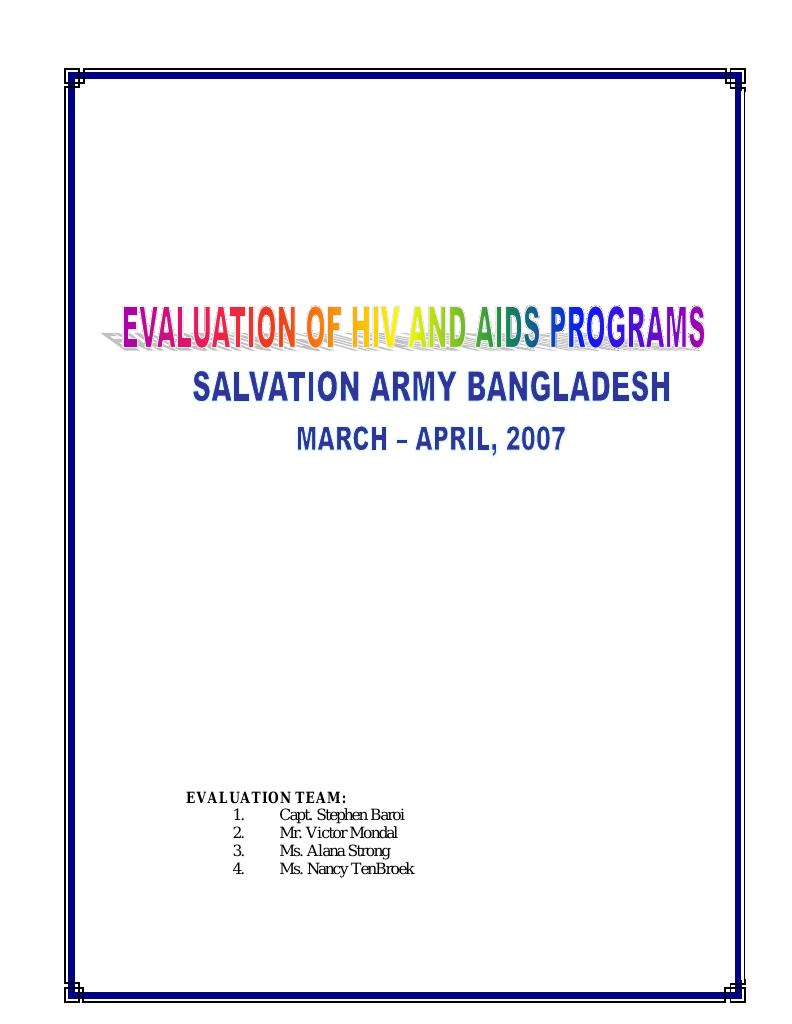Evaluering
Evaluation of HIV and AIDS Programs. Salvation Army Bangladesh, March-April, 2007
Background The Salvation Army Bangladesh started the programme in 1994. The project is mostly and HIV/AIDS educational prevention project, which has integrated into all the Salvation Army Community Health and Development projects and communities where the Church has a presence. Activities involves awareness raising, production of posters and pamphlets, counselling training, community organization and mobilization, and networking with other NGOs and GOs. The project has also established two outreach centres for women who are in prostitution. Purpose/objective • Evaluate project performance as regards to preparation and implementation of plans, follow up on achievements of targets and objectives (impact).• Make recommendation on possible improvements in project design and organization and on modifications to targets, objectives and plans for future implementation.• Assess the future sustainability of the different activities supported by the project after the phasing out of external financial support• Summary of Best Practices• Summary of Lessons learned Methodology The evaluation was participatory in nature and included site visits, semi formal interviews with key staff and community members, focus group discussions, paper review of plans, progress reports, previous evaluations (including action research), budgets and job descriptions, participatory appraisal exercises (SWOT, timeline, stakeholder analysis, needs chart) and stakeholder discussions. The evaluation followed the guidelines of "Appreciative Inquiry" and interviews were conducted through a series of questions which generated case examples based on perceived strengths of the project. Key findings • The Salvation Army is able to address needs in high risk groups - work outside of the conventional community development group model. This is clearly a best practice within the organization.• The Salvation Army has been the frontrunner or lead agency in addressing "new" or pertinent issues. Eg. A lead organization in starting the Stop the Traffik network of Christian NGOs in Bangladesh.• Salvation Army knows and dialogues with all lead organizations in HIV and AIDS.• The HIV and AIDS project is integrated n everything the organization do.• The community, especially through the CSGs,are taking an increased role in initiating HIV and Aids awareness activities-there is ownership of the issues by many of the CSGs.• The project needs to consider sustainability, particularly in respect to the brothel programming. The community work would seem to have a somewhat clearer route to sustainability through the CSG's. However, the work with the brothels should have a clear visioning and planning workshop, upon which sustainability of the program should be more clearly thought out. Recommendations 1. A stronger curriculum base needed. We recommend that the S.A. really work to develop specific curriculum packages for the following groups - for adolescents, for schools, for sex workers, for Corps, for community groups. Whilst there can be some flexibility, a clear curriculum is needed to support the staff.2. In relation to the above recommendation, a clear baseline measurement system is needed - and then this can be reassessed every year. They need to have more data on how attitudes, knowledge and behavior is changing.3. The Salvation Army can support the broader Christian community through their curriculum and by developing materials for HIV and Aids Sunday, etc. Programs developed and carried out through their own churches and structures can be then modeled and scaled up by the broader church community through NCFB and/or NCCB.4. The Salvation Army should continue to find avenues for income generation. Skill development programs should be a focus, enabling clients and participants to gain employment earning outside of the Salvation Army fold.5. The multi faceted and integrated approach should be continued. This needs to be clearly articulated in the plans as to how it all links to a comprehensive HIV and Aids program.6. The organization should probe possibilities of linking more closely with the Government programs in HIV and Aids.7. The Salvation Army should continue its active role in the HIV and Aids Forum network and continue to disseminate best practices through this venue.8. All staff in the community development programs and in the Corps work should be trained in HIV and Aids awareness and education. HIV and Aids programming should be considered as part of the regular work in their job description and not be seen as additional work, nor be paid as additional work but as part of their regular salary as determined through their job description.
